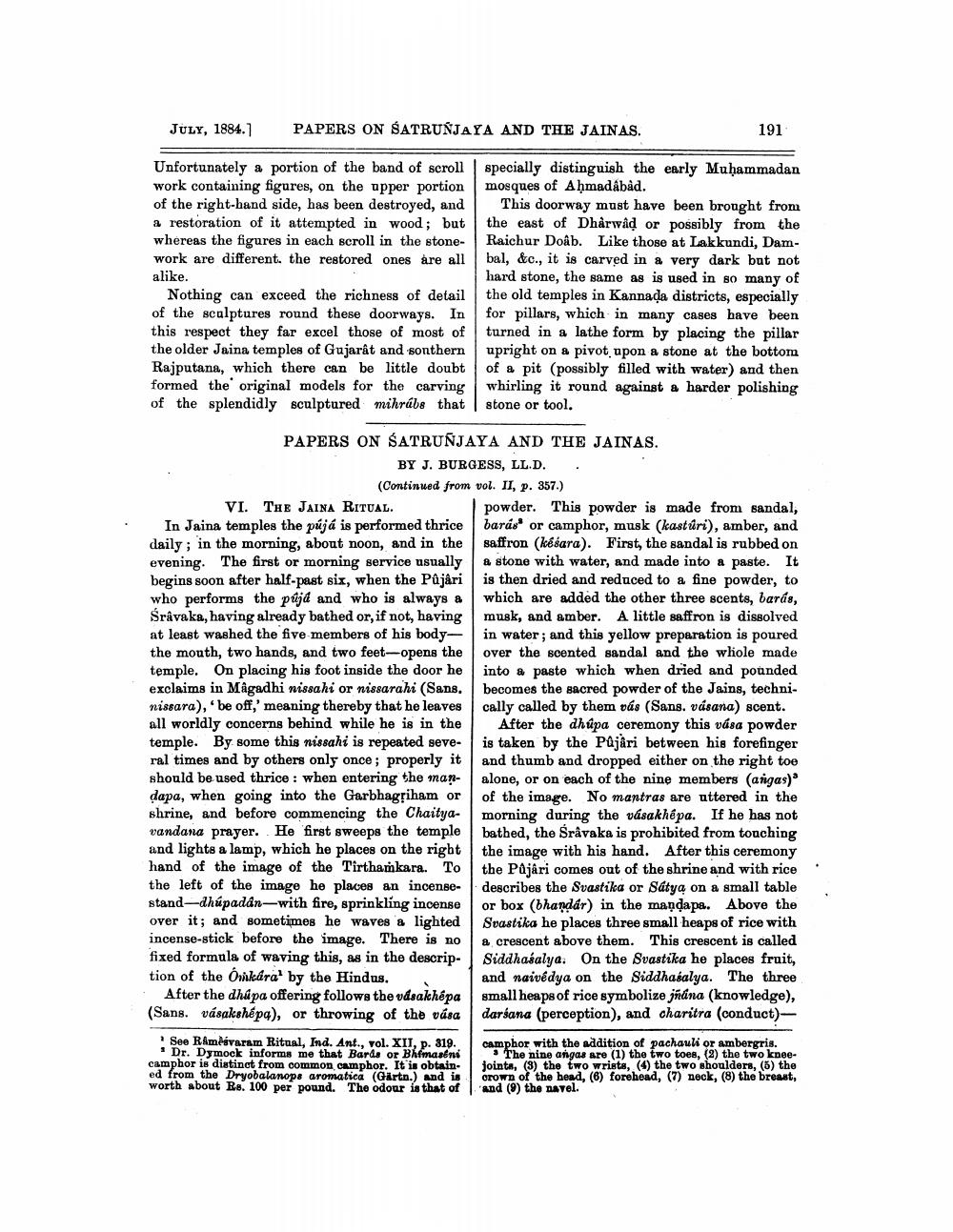________________
JULY, 1884.7
PAPERS ON SATRUNJAYA AND THE JAINAS.
191
Unfortunately a portion of the band of scroll specially distinguish the early Muhammadan work containing figures, on the upper portion mosques of Ahmadábåd. of the right-hand side, has been destroyed, and | This doorway must have been brought from a restoration of it attempted in wood; but the east of Dhårwad or possibly from the whereas the figures in each scroll in the stone- Raichur Doâb. Like those at Lakkundi, Damwork are different. the restored ones are all bal, &c., it is carved in a very dark but not alike.
hard stone, the same as is used in so many of Nothing can exceed the richness of detail the old temples in Kannada districts, especially of the scalptures round these doorways. In for pillars, which in many cases have been this respect they far excel those of most of turned in a lathe form by placing the pillar the older Jaina temples of Gujarat and sonthern upright on a pivot upon a stone at the bottom Rajputana, which there can be little doubt of a pit (possibly filled with water) and then formed the original models for the carving whirling it round against a harder polishing of the splendidly sculptured mihrábe that stone or tool.
PAPERS ON SATRUNJAYA AND THE JAINAS.
BY J. BURGESS, LL.D. .
(Continued from vol. II, p. 357.) VI. THE JAINA RITUAL.
powder. This powder is made from sandal, In Jaina temples the pújá is performed thrice barás" or camphor, musk (kastúri), amber, and daily; in the morning, about noon, and in the saffron (kéśara). First, the sandal is rubbed on evening. The first or morning service usually a stone with water, and made into a paste. It begins soon after half-past six, when the Půjári is then dried and reduced to a fine powder, to who performs the půjd and who is always a which are added the other three scente, barás, Sravaka, having already bathed or, if not, having musk, and amber. A little saffron is dissolved at least washed the five members of his body- in water; and this yellow preparation is poured the mouth, two hands, and two feet-opens the over the scented sandal and the whole made temple. On placing his foot inside the door he into a paste which when dried and pounded exclaims in Magadhi nissahi or nissarahi (Sans. becomes the sacred powder of the Jains, techni. nissara), 'be off,' meaning thereby that he leaves cally called by them vás (Sans. vásana) scent. all worldly concerns behind while he is in the After the dhúpa ceremony this vása powder temple. By some this nissahi is repeated seve- is taken by the Pajari between his forefinger ral times and by others only once ; properly it and thumb and dropped either on the right toe should be used thrice : when entering the man- alone, or on each of the nine members (angas) dapa, when going into the Garbhagriham or of the image. No mantras are uttered in the shrine, and before commencing the Chaitya- morning during the vásakhépa. If he has not vandana prayer. He first sweeps the temple bathed, the Sravaka is prohibited from touching and lights a lamp, which he places on the right the image with his hand. After this ceremony hand of the image of the Tirthamkara. To the Pajari comes out of the shrine and with rice the left of the image he places an incense- describes the Svastika or Satya on a small table stand-dhúpadán-with fire, sprinkling incense or box (bhandar) in the mandapa. Above the over it; and sometimes he waves & lighted Svastika he places three small heaps of rice with incense-stick before the image. There is no a crescent above them. This crescent is called fixed formula of waving this, as in the descrip- Siddhasalya. On the Svastika he places fruit, tion of the Onkára' by the Hindus.
and naivedya on the Siddhasalya. The three After the dhipa offering follows the vdsakhépa small heaps of rice symbolize jñána (knowledge), (Sans. vásakshépa), or throwing of the vása darsana (perception), and charitra (conduct)--
See Ráméávaram Ritual, Ind. Ant., vol. XII, p. 319. camphor with the addition of pachauli or ambergris.
Dr. Dymock informs me that Bards or Bhimasena The nine angas are (1) the two toes, (2) the two kneecamphor is distinct from common camphor. It is obtain- jointa, (3) the two wrists, (4) the two shoulders, (5) the ed from the Dryobalanops aromatica (Gärtn.) and is crown of the head, (6) forehead, (7) neck, (8) the breast, worth about Rs. 100 per pound. The odour is that of 'And (9) the navel.




